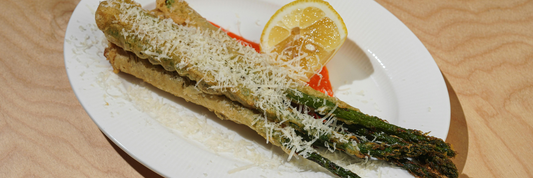Sugarcane fiber has a wide range of application, including food and beverage industry. Today. Let’s discover this materials and reason why it is so popular.
Related: Guide to Sugarcane Fiber Packaging
What is Sugarcane Fiber? What Are Features of Sugarcane Fiber?
Sugarcane Fiber Definition
Sugarcane fiber, also called bagasse, is the fibrous material that remains after the juicy part of sugarcane stalks is extracted to make sugar. It's like the leftover pulp – a dry, pulpy, and fibrous residue.
Features of Sugarcane Fiber
Following are the features of sugarcane fiber:
Texture and Color:
- Coarse and fibrous: Unlike soft cotton fibers, sugarcane fiber is rough and slightly abrasive. This texture makes it good for scrubbing and cleaning, but less ideal for direct contact with skin.
- Light beige or brown: The natural color of bagasse varies from a pale beige to a light brown, depending on the sugarcane variety and processing methods.
Strength and Flexibility:
- Moderately strong: While not as strong as steel or wood, sugarcane fiber offers sufficient tensile strength for many applications like packaging and building materials.
- Flexible and pliable: Bagasse can be molded and shaped into various forms, making it suitable for creating plates, trays, and other products.
Water Absorption and Resistance:
- Highly absorbent: Due to its cellulose content, sugarcane fiber readily absorbs liquids. This makes it ideal for thickening foods or producing moisture-wicking materials.
- Water-resistant: Although absorbent, bagasse treated with certain chemicals or coatings can resist water penetration, enhancing its durability for use in containers and building materials.
Thermal Properties:
- Good insulator: Bagasse's air pockets trap heat, making it an effective thermal insulator for walls, furniture, and packaging.
- Fire retardant: With proper treatment, sugarcane fiber can exhibit some fire-resistant properties, making it a safer material for certain applications.
Biodegradability:
Decomposes quickly: One of the most valuable features is its biodegradability. Unlike plastic, bagasse breaks down naturally within months, minimizing waste and promoting sustainability.
Additional Features:
- Lightweight: Bagasse is lighter than many other materials, making it ideal for applications where weight is a concern.
- Renewable resource: As a byproduct of sugarcane production, bagasse offers a sustainable source of material.
What Is Sugarcane Fiber Used For?
Sugarcane fiber have a wide range of application. Here are some common uses of sugarcane fiber:
Packaging and Products:
- Sustainable food containers: From plates and bowls to cups and trays, sugarcane fiber offers a biodegradable alternative to traditional plastic and paper packaging for food service and takeaway meals.
- Coffee pods and tea bags: Eco-conscious coffee and tea brands are switching to bagasse-based pods and tea bags, replacing the plastic options that typically end up in landfills.
- Biodegradable cutlery: Sturdy and heat-resistant cutlery made from sugarcane fiber is an excellent choice for picnics, parties, and everyday use.
Building Materials:
- Insulation panels: Bagasse's natural insulating properties make it ideal for creating eco-friendly building materials that improve energy efficiency.
- Soundproofing materials: Its fibrous structure helps absorb sound, making it useful for acoustic panels in walls and ceilings.
- Furniture and interior décor: Panels and boards made from sugarcane fiber can be used to create sustainable furniture pieces and decorative elements for homes and offices.
Other Uses:
- Biofuel production: The leftover sugars in bagasse can be fermented to produce ethanol, a renewable biofuel for cars and other vehicles.
- Paper production: Bagasse can be pulped and used to make paper, offering a greener alternative to traditional wood pulp for certain paper products.
- Composting: After use, sugarcane fiber products can be composted, returning valuable nutrients to the soil and minimizing waste.

How is Sugarcane Fiber Sustainable?
Sugarcane fiber is sustainable for many reasons, including:
- Renewable Resource: It's a byproduct of sugarcane production, utilizing waste material that would otherwise be discarded. This reduces reliance on virgin resources like trees and petroleum for packaging and building materials.
- Biodegradable and Compostable: Unlike plastic, bagasse naturally decomposes within months, returning valuable nutrients to the soil and minimizing long-term waste accumulation in landfills. This promotes a circular economy where waste becomes a resource.
- Reduced Carbon Footprint: Compared to traditional materials like plastic and paper, sugarcane fiber production generally requires less energy and emits fewer greenhouse gases. This contributes to mitigating climate change and lowering the environmental impact of various products.
- Water Conservation: Compared to paper production, bagasse processing typically requires less water, making it a valuable option in water-scarce regions. This helps conserve precious resources and reduce environmental strain.
- Reduced Pollution: By replacing plastic and traditional paper with sugarcane fiber, we can lower the consumption of fossil fuels and chemicals used in their production. This helps minimize air and water pollution associated with these industries.
- Improved Soil Health: When composted, sugarcane fiber enriches the soil with organic matter and nutrients. This improves soil fertility, promotes plant growth, and reduces the need for chemical fertilizers.
- Biodiversity Benefits: By substituting other materials with bagasse, we can decrease pressure on forests and other ecosystems used for resource extraction. This helps protect biodiversity and maintain natural habitats.
- Social Responsibility: Utilizing bagasse can create new economic opportunities for sugarcane farmers and communities living in sugarcane-growing regions. This contributes to rural development and improves livelihoods.
When comparing to the other materials like styrofoam, plastic, bioplastic, cardboard paper, that are commonly used in food packaging, sugarcane stand out for several reasons. Here is a table comparing them across sustainable factors:
|
Feature |
Sugarcane Fiber |
Styrofoam |
Plastic |
Bioplastic |
Cardboard Paper |
|
Material Source |
Renewable byproduct of sugarcane production |
Petroleum-based fossil fuel |
Petroleum-based fossil fuel |
Plant-based sources like corn starch or cellulose |
Recycled wood pulp or virgin trees |
|
Biodegradability |
Decomposes in months |
Can take centuries to decompose, often breaking into microplastics |
Can take centuries to decompose, though some newer varieties claim faster breakdown |
Varies depending on composition, some can take years |
Decomposes months |
|
Compostability |
Yes |
No |
No, unless specifically labelled compostable |
Varies depending on composition, some are compostable |
Yes |
|
Carbon Footprint |
Lower than most plastics and paper |
High due to fossil fuel extraction and production |
High due to fossil fuel extraction and production |
Varies depending on source and production process |
Moderate, can vary depending on recycled content and production processes |
|
Renewable Resource |
Yes |
No |
No |
Partially, some are made from renewable sources |
Partially, can be made from recycled content |
Sugarcane Fiber for Food and Beverage
Is Sugarcane Fiber Safe to Use with Food?
Sugarcane fiber is generally considered safe for use with food. Here are the main reasons:
- Natural materials: Derived from a renewable resource, bagasse is not treated with harmful chemicals often found in plastic or other synthetic materials.
- Processing: The manufacturing process removes impurities and ensures the final product meets food safety standards.
- Regulations: Approved by relevant authorities for food contact, meaning it undergoes rigorous testing to ensure no harmful substances leach into food.
- Widely used: Many food brands and restaurants already use sugarcane fiber containers for various food items, signifying its safety and suitability.
What Are Considerations When Using Sugarcane Fiber Containers?
Here are things that need to consider when use choose sugarcane fiber containers:
- Check product specifications: Always check the manufacturer's instructions and labeling for specific temperature limitations and suitability for different types of food.
- Use liners for extra protection: Consider using liners made from natural materials like parchment paper or compostable options for added grease resistance or to extend the container's lifespan.
- Store and dispose responsibly: Store sugarcane fiber containers in a cool, dry place and dispose of them properly in compost bins or designated recycling facilities, depending on the product's labeling.
- Cost: Compare the cost of sugarcane fiber packaging to other options and weigh the environmental benefits against your budget.
Sugarcane Fiber Products from Kimecopak
At Kimecopak, we have different types of food packaging made from sugarcane, including:
- Biodegradable straws: sugarcane straws size 8mm, 12mm
- To-go-box: sugarcane clamshell
- Biodegradable beer rings: sugarcane beer ring 4 pack, 6 pack




